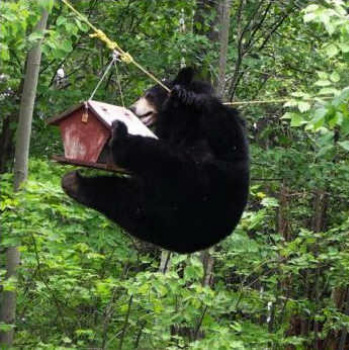People’s preferred pastimes are numerous. Some are active, like baseball, football, and other such team sports, and others, more passive, like stargazing or bird watching. These latter hobbies can be quite rewarding for their practitioners, since they require them to learn quite a bit about the subjects of their observation. This kind of learning can be difficult at first, but invariably leads to a relaxing and rewarding time spent with others knowledgeable about the subject later, or in its most rewarding incarnation, spent teaching. Here, we’ll look at a few different kinds of bird feeders, to help you get started on this often overlooked pastime.
Plastic Feeders
Plastic gravity feeders are perhaps the most common bird feeders, as they’re the easiest to set up and easiest to deploy. Gravity feeders have a hole in the top that’s accessible via removal of a plastic cap. Feed is placed into this hole until the cylinder is filled, and birds have access to the feed through either one or several cuts in the bottom of the cylinder. The main advantages to these feeders are the facts that they’re cheap, easy to deploy, easy to refill, and easy to clean. Some people don’t like these feeders, however, because they’re only suitable for a certain set of birds, and sometimes can be bad for the environment (if they detach in high winds or break apart during storms, for instance). Still, they’re a great beginner’s option, and most people just getting into birdwatching can’t go wrong with one.
“Pan” Feeders
Pan feeders are dish-like feeders that are filled with food and can either be hung or laid on a flat surface. These are good for people who want an up-close-and-personal look at their birds, are attracting a specific species of bird, or just like to be able to see the birds that fly in from a better angle than might be afforded by a mounted vertical feeder. The downside to pan feeders is that most have to be refilled quite frequently, as birds have direct access to feed. This also means they have to be cleaned quite frequently. On the upside, they’re good for attracting particular kinds of birds and their mates or relatives. Pan feeders are good for birdwatchers of any skill level, but are preferred by those who have some idea as to just what they want to see.
Birdhouse Dispensers
Some birdhouse designs incorporate a bird feeder as well. These are becoming increasingly common. The advantages to these are that they tend to be well made, attract many common and fun-to-watch birds, and are easy to set up and refill. The downside is that they’re really made for just one bird at a time. This makes them well suited for those who are just getting in to bird watching and want to learn each bird species as they go along. For pure watching, however, the gravity feeders are probably a better choice. These are great for kids, however, and that makes them popular purchases for parents.
Plastic Feeders
Plastic gravity feeders are perhaps the most common bird feeders, as they’re the easiest to set up and easiest to deploy. Gravity feeders have a hole in the top that’s accessible via removal of a plastic cap. Feed is placed into this hole until the cylinder is filled, and birds have access to the feed through either one or several cuts in the bottom of the cylinder. The main advantages to these feeders are the facts that they’re cheap, easy to deploy, easy to refill, and easy to clean. Some people don’t like these feeders, however, because they’re only suitable for a certain set of birds, and sometimes can be bad for the environment (if they detach in high winds or break apart during storms, for instance). Still, they’re a great beginner’s option, and most people just getting into birdwatching can’t go wrong with one.
“Pan” Feeders
Pan feeders are dish-like feeders that are filled with food and can either be hung or laid on a flat surface. These are good for people who want an up-close-and-personal look at their birds, are attracting a specific species of bird, or just like to be able to see the birds that fly in from a better angle than might be afforded by a mounted vertical feeder. The downside to pan feeders is that most have to be refilled quite frequently, as birds have direct access to feed. This also means they have to be cleaned quite frequently. On the upside, they’re good for attracting particular kinds of birds and their mates or relatives. Pan feeders are good for birdwatchers of any skill level, but are preferred by those who have some idea as to just what they want to see.
Birdhouse Dispensers
Some birdhouse designs incorporate a bird feeder as well. These are becoming increasingly common. The advantages to these are that they tend to be well made, attract many common and fun-to-watch birds, and are easy to set up and refill. The downside is that they’re really made for just one bird at a time. This makes them well suited for those who are just getting in to bird watching and want to learn each bird species as they go along. For pure watching, however, the gravity feeders are probably a better choice. These are great for kids, however, and that makes them popular purchases for parents.

 RSS Feed
RSS Feed